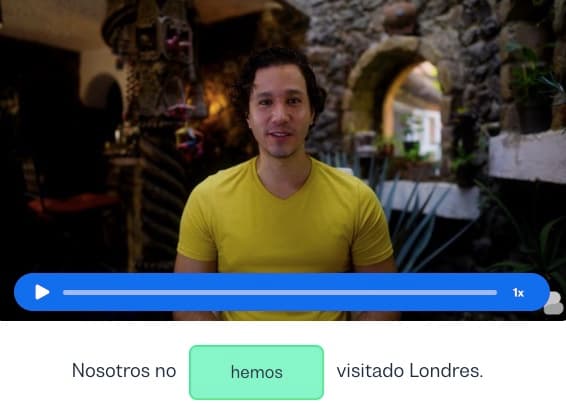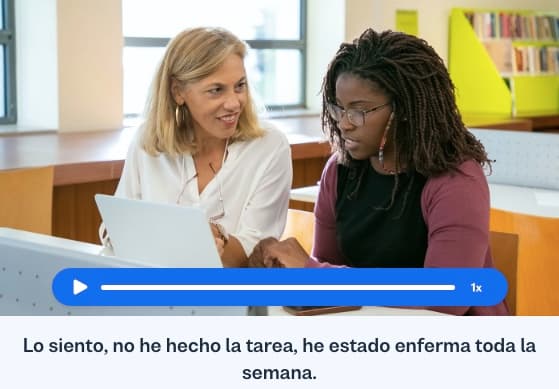I want to learn...
You have a meeting with a Spanish coworker, and before you dive into the agenda, you want to ask if they have received your latest email. To do so, you can use the pretérito perfecto, or present perfect tense in Spanish.
Here, you’ll learn to conjugate regular and irregular verbs and structure your sentences using present perfect tense in your daily conversations.
¡Comencemos!
Let's get started!
Pretérito perfecto: The basics
Take a look at this example sentence in the present perfect tense:
¿Has recibido mi correo electrónico? (Have you received my email?)
In this sentence, we have two verbs at play:
An auxiliary verb has (haber), which tells us who did the action
A main verb recibido (recibir), which tells us which action they did
Every pretérito perfecto sentence is made using both an auxiliary and a main verb. For the auxiliary verb, we use haber (to have) conjugated in the present tense.
Haber (to have) - present tense
| Pronoun | Conjugation |
|---|---|
| yo | he |
| tú | has |
| el/ella | ha |
| usted | ha |
| nosotros/nosotras | hemos |
| vosotros/vosotras | habéis |
| ellos/ellas | han |
| ustedes | han |
Note: Vosotros /vosotras is mainly used in Spain and not in Latin America, where they tend to use usted / ustedes instead.
To form the correct conjugation for the main verb, we use the past participle. For regular verbs, this looks like this:
-AR verbs:-ado (for example: hablar [to talk / speak] 🡪 hablado)
-IR / ER verbs:-ido (for example:comer [to eat] 🡪comido / recibir (to receive) 🡪recibido)
Luckily, the sentence structure for the pretérito perfecto is straightforward and looks like this:
subject + auxiliary verb haber + past participle + everything else
Let’s try it for ourselves.
What would a sentence look like using the verb comer? How could you say, “I have already eaten my vegetables”?
Ya he comido mis verduras.
Great! Now that we’ve covered the basics with regular verbs in thepretérito perfecto, let’s look at some irregular verbs.
Present perfect tense: Spanish irregular verbs
As usual, there are always exceptions when using irregular verbs.
For irregular verbs in the pretérito perfecto, you follow the same guidelines and sentence structure as you do with regular verbs (auxiliary haber + main verb). The only difference will be that you need to use the irregular conjugation of the verb’s past participle rather than following the past participle conjugation patterns for regular verbs.
Here is a list of irregular verbs and their past participles:
hacer (to do/make): hecho
ver (to see): visto
volver (to return/go back): vuelto
poner (to put): puesto
ir (to go): ido
decir (to say): dicho
ser (to be): sido
As you can see, these verbs do not follow the regular conjugation patterns for the past participle.
Here are some examples of using irregular verbs in sentences with the
Yo he hecho mi tarea. (I have done my homework.)
Vosotros ya habéis visto esa película. (You (plural) have already seen that movie.)
Usted ha puesto las llaves sobre la mesa. (You (formal) have put the keys on the table.)
Nice work! You have understood how to form sentences using the pretérito perfecto for both regular and irregular verbs.
Now let’s look at the different situations where we can use the Spanish present perfect.
Using the pretérito perfecto
The pretérito perfecto is used in three main situations:
To talk about actions that have happened in the recent past
To talk about past actions connected with the present moment
To talk about actions without specifying the time when they occurred
To get a better idea of these situations, let’s look at some examples.
Pretérito perfecto to talk about actions that happened in the recent past:
Nosotros hemos llegado tarde a la reunión. (We have arrived late to the meeting.)
!start2!Pretérito perfecto to talk about past actions connected with the present moment:
Ha sido un día maravilloso. (It has been a wonderful day.)
!start3!Pretérito perfecto to talk about actions without specifying the time when they occurred:
¿Has ido tú al cine alguna vez? (Have you (informal) ever been to the movies?)
Getting the hang of things? Excellent. We have just one more thing to cover: knowing when to use the pretéri to perfecto and pretérito indefinido.
Pretérito perfectovs.pretérito indefinido
The pretérito perfecto and pretérito indefinido (the simple past) are two different tenses to talk about the past with distinct uses. Let’s break it down.
As we mentioned, the pretérito perfecto is used for actions that have happened in the recent past, actions that have a connection to the present, and actions that happened at a time not specified.
The pretérito indefinido, however, is used to describe events that happened in the past and do not have a direct connection to the present. It also focuses on actions that happened and ended at a specific point in time.
Let’s look at some examples of both:
Pretérito perfecto: ¿Has comido en ese restaurante antes? (Have you eaten at that restaurant before?)
Pretérito indefinido:Comí en ese restaurante la semana pasada. (I ate at that restaurant last week.)
The first example emphasizes the experience of eating at that restaurant in the recent past and has relevance to the present. The second focuses on the specific point in time at which the speaker ate at that restaurant.
On a cultural note, the main past tense used in Spain is the pretérito perfecto, while in Latin America, they tend to use the pretérito indefinido. Of course, this also varies according to the region and the speaker’s preference. (Check out our article on the differences in Spanish used in Spain and Latin America)
If you are trying to figure out which tense you should use, try asking yourself if your situation or action relates to the present or occurred at an unspecified time. If so, your best bet is the pretérito perfecto.
Let’s review
By now, you’ve seen how to form the pretérito perfecto (present perfect) Spanish tense, as well as the situations it’s best suited for.
To recap, the pretérito perfecto is formed using an auxiliary verb (haber– to have) in its present tense conjugation with a main verb in its past participle.
For regular verbs, you can use the normal conjugation patterns for the past participle, but for irregular verbs, you’ll need to memorize them.
The pretérito perfecto is used for situations where you are talking about actions that happened in the past, have a connection to the present, or occurred at an unspecified time.
This is very useful when talking about your day, indicating an event that is related to the present, or describing things such as a time period or context.
Great work!
Newlanguages


